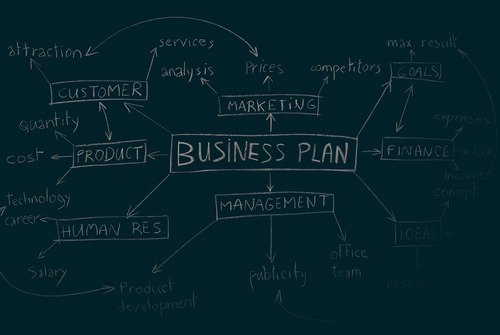Strategic planning is essential for any enterprise to be successful.

INTRODUCTION
In strategic planning, upper-level management specifies the company’s ultimate goals and lays out the road map to get there. In order to realize its vision, the organization needs to establish a set of objectives and decide the best order in which to achieve them.
The time horizon for strategic planning is generally three to five years, but it can be longer. When it comes to allocating resources within a specific time frame, for example, business planning tends to focus on more immediate problems. In some cases, the time frame of a company plan may span several years.

Ultimately, your planning efforts will yield a strategic plan. It is typically recorded in a written or recorded format. Workers, clients, partners, and investors may easily gain access, comprehend, and put into practise these plans.
Changes in the commercial, industrial, legal, and regulatory spheres must be factored into strategic plans on a regular basis. Changes in the strategic environment may necessitate adjustments to an existing plan.

Even if one is just starting out or looking into a new opportunity, one should always prepare ahead before making any major moves in the firm. Strategic planning helps businesses increase their chances of realizing their full potential by articulating the company’s purpose and establishing lofty goals.
By learning the steps and components of strategic planning, you can create a plan that will help your business succeed. What is strategic planning, what does it entail, what does it tell you, and what makes a good strategic plan? All these questions and more will be answered in this essay.

FACTORS INVOLVING STRATEGIC PLANNING PROCESS:
Identify the purpose and goals of the strategic plan
Defining the plan’s broad objective and expected outcomes is a crucial first step in clarifying the plan’s strategic direction. How successfully the strategy achieves its stated goals, such as explaining the organization’s overarching mission and guiding values, will be used to determine its success. It will be much easier to communicate and implement the plan if it is in line with the organization’s wider goals and values.
Analyze the internal and external environment
The internal and external environments can be examined after the plan’s goals and objectives have been established. The market and the company’s competitors are taken into account as part of a SWOT analysis, together with the company’s own strengths, weaknesses, opportunities, and threats. The study’s findings will help the company better evaluate its SWOT (strengths, weaknesses, opportunities, and threats) (strengths, weaknesses, opportunities, and threats).

Develop a SWOT analysis
A SWOT analysis can be created using data collected from both inside and outside the company. The first step is to do a SWOT analysis, which looks at the organization’s strengths, weaknesses, opportunities, and threats. The process of developing a strategy might then begin.
Set priorities and develop action plans
A company’s ability to prioritize and make effective strategies is enhanced after conducting a SWOT analysis. In practice, this involves zeroing in on what matters most and brainstorming potential solutions. The success of a business can be improved by prioritizing activities and developing strategies to carry them out.

Communicate and implement the plan
Finally, make strategy planning easier by ensuring everyone in the team is working toward the same goals. If everyone is on the same page, then the plan has a good chance of going off without a hitch. This makes achieving one’s aims easier.
Organizations that fail to undertake adequate strategic planning will fail to meet their objectives. With some planning and segmentation, businesses may develop a strategy that is simpler to articulate and put into action. Both the results and the efficiency with which resources are used will increase.

EXPLAINING STRATEGIC PLANNING AND ITS IMPORTANCE
Strategic planning is beneficial for businesses because it helps them look ahead to the future, identify long-term objectives, and create a strategy to reach those objectives. A well-developed statement outlining the organization’s aims, values, and strategies for getting there is the ultimate product of this process.
An organization’s current status will start going downhill if it doesn’t have a plan it can follow as a starting point and tweak as it goes. The business plan explains the company’s overarching purpose, vision, and objectives.

An organization’s mission and vision statements helps draw basic outlines of how their strategic vision is going to play out and if it is in accordance with the long term strategy which are put into place to meet organizational goals and objectives.
If you take stock of your business on a regular basis, you’ll be able to see how well actual results compare to forecasts. This data can be used to either modify or fortify the way your business is currently managed. If you want everyone on your team to be working toward the same goals, you must communicate your plan to them.

Reviewing and following up on your business will highlight strengths and weaknesses in your business so that you can continue with what works well and eliminate what is hindering the growth of your business.
A company’s long-term success depends on its leaders’ making decisions that further its overall goals. This can help make sure that the company’s long-term interests are considered whenever a decision needs to be made.
Last but not least, strategic planning can help improve the efficiency of internal channels of communication and teamwork. All essential stakeholders should be involved in the planning process, and the strategic plan should be communicated effectively to ensure that everyone is on the same page and working toward the same goals. Having this in common may increase drive and productivity.

THE STRATEGIC PLANNING PROCESS
The strategic planning process typically consists of five key steps:
Step 1: Setting goals and objectives
A corporation can’t move forward with strategic planning until its objectives are established. This can be achieved if the organization has clearly articulated its vision and is working toward concrete, measurable objectives.
Step 2: Conducting a situational analysis
After deciding what it is the organization hopes to accomplish, it is important to assess the state of its external environment to see if it will pose any obstacles. Part of this procedure involves conducting a SWOT analysis of the market, the competition, and the company itself.

Step 3: Develop a strategic plan
Our current understanding of the company’s circumstances, along with its stated aims and objectives, allows us to formulate a plan for the company’s future. For our strategy to be successful, it must detail the steps we will take to actually accomplish our objective.
Step 4: Implementing the plan
Once the strategy has been created, the following step is for the company to put it into action. The implementation phase entails allocating resources, briefing employees on their roles, and putting plans into effect. To ensure a successful launch, it is important to plan ahead, keep everyone informed, and closely track progress.

Step 5: Monitoring and evaluating the plan
Strategic planning culminates in monitoring progress toward goals and adjusting course as needed. Successful strategy maintenance requires frequent attention and tweaks.
For an organization to succeed in the long run, strategic planning is crucial. Establishing defined goals and objectives, doing a scenario analysis, developing a strategic plan, putting it into action, and reviewing the results can help businesses achieve their objectives and stay competitive in a rapidly changing business environment.

VITAL ELEMENTS OF STRATEGIC PLANNING
A well-thought-out strategy sets the stage for the organization’s future success and defines it precisely at every level. They include:
Define your vision
A company’s long-term goals are outlined in the company’s vision statement. It serves as a roadmap for the company’s current and future since it specifies its ultimate goals.
A successful strategic plan document will have strategic goals and objectives moving hand in hand with the business’s strategic plan.
The company’s long-term goals are summed up in these three simple sentences. A well-defined vision statement may do the same for your organization by giving everyone something to work toward.

Create your mission
One can think of a company’s vision as its ultimate goal, and its mission as its strategy for achieving that goal.
A mission statement, in a strategic planning template, basically helps the organization to pan out whether or not their strategic framework is moving in line and in the same direction as their strategy execution.
Without a defined purpose, your organization lacks the motivation and direction necessary for success. When members inside an organization have varying interpretations of what the organization’s vision comprises, it can lead to inefficient action.

Set your objectives
An objective is a specific, quantifiable, and time-bound aim that an individual or group has set for itself. Generally speaking, the best goals are those that are specific, measurable, and supported by a variety of strategic actions taken at all levels of the organization.
In order for your plan to be successful, making sure that employee retention, in their new roles and departments, must be looked after.
Having a clear definition of success at the outset helps you track your achievements along the way. Well-defined objectives provide a standard against which strategic initiatives and the overall health of an organization can be assessed.

Develop your strategy
The strategy of an organization is its long-term plan to achieve its objectives. Individual objectives may also have their own plans, although overall, strategic plans tend to be three to five years in duration.
Strategy that works is the result of combining foresight with decisive action. A company’s strategy provides many more specifics than its general vision, aim, and objectives. Inside, we’ll talk exclusively about how they’re tailored to the specific requirements of each business and the current state of the industry.
Short-term goals and activities should be derived from long-term goals, and strategies should foster innovative approaches to resolving problems and avoiding traps.

Outline your approach
Approaches offer a systematic way to put a plan into action. The strategy is a blueprint for addressing fundamental questions that will inform the development of operational plans. In addition, it provides direction for carrying out the organization’s overall strategy. Therefore, planning can show how a positive outlook relates to strategies, outcomes, and the ultimate objective of the business.
The project management team should create a financial plan which helps to evaluate progress and also monitor progress.

Get down to tactics
Tactics are the steps an organization takes to put a strategic plan into motion. Tactics play a crucial role in the success of any strategy. What matters are the acts, because they are what bring about change.
High-performing teams are crucial in achieving specific objectives and ensuring customer satisfaction. However, strategic issues must be considered when creating project plans for future opportunities. It’s essential to identify potential roadblocks and develop a plan to overcome them.
Although there may appear to be no connection between the various techniques, a deeper dive reveals that the most effective ones are those that directly support the company’s overall strategy, objectives, mission, and vision.

What are the characteristics of a good strategic plan?
The strategic planning aspects alone aren’t enough to make a plan successful; it needs to also include other characteristics.
Here are some tips for making the most of your strategic plan in terms of concrete corporate objectives:
Detailed goals and actions
Key performance indicators can be utilized to gauge progress toward objectives thanks to the detail you’ve put into your strategy. In addition, it ensures that you’ll be able to establish worthwhile corporate targets.
Realistic goals
One should aim for things that are both realistic and worthwhile. If you set unrealistic goals for your business, you risk investing in the incorrect areas.

Clear deadlines
As you draught your strategic plan, be sure to incorporate firm deadlines for achieving key milestones. As a result, your team will feel more accountable and motivated to complete their tasks by the deadlines you set, improving the likelihood that your goals will be achieved.
Room for changes or adaptations
The implementation of your strategic plan may result in adjustments to your company’s needs as a result of factors outside your control, such as the state of the economy, the state of the industry, or feedback from customers. That’s why it’s important to outline all the movable pieces of your strategy. Consider the time frame and funding available for a project as an example.
What is the difference between a strategic plan and a business plan?
While business plans concentrate on the near future, strategic plans help businesses achieve their long-term goals. Companies utilize strategic plans both when first forming and as they grow and evolve through time. However, firms use business plans, particularly when they are just starting out. They utilize it to outline the fundamentals of their business, such as their strategy for reaching customers and raising capital.
What separates a strategic strategy from a business plan is the focus on objectives. Businesses that are already up and running will use the strategic plan for growth, whereas entrepreneurs starting a new venture will use business plans. Each tactic also has its own timetable. While a strategic plan may span several years, a well-thought-out business strategy can be implemented in a year or less. A business plan, like a strategic plan, can be used in many contexts and offer many benefits.

Benefits of using a strategic plan
The primary benefit of a strategic plan is the increase in profits it can bring, which can then be reinvested in the company in the form of things like new machinery and employee education. It’s beneficial for companies because it broadens their customer base and raises awareness of their name.
Uses of a strategic plan
Established businesses can use the strategic plan to map out their ideal future, whether that’s more expansion, a shift in focus to a new product line, or even a transition to charity status. The strategic plan can help a company maximize its earnings and return on investment by allocating resources more effectively. With the aid of a well-thought-out strategic plan, you can achieve not only a sustainable operating system, but also a competitive advantage over similar organizations.
Benefits of using a business plan
Entrepreneurs and start-ups can benefit from having a business plan because it helps them structure their ideas into a workable framework with defined roles and responsibilities. Building a sustainable, successful business requires careful planning, which is why these new ventures put so much emphasis on creating a business strategy.
Uses of a business plan
A business plan is a strategic document used by startups to map out their future expansion. You can use it to see if your business idea will work and where you can get the funding you need to make it a reality. When a business receives capital, it may immediately begin putting into motion the countless steps required to get its product into the world, including finding suppliers, developing a website, and hiring qualified staff.
THE STRATEGIC MANAGEMENT PROCESS
Managers need to be able to zero in on the strategies that will boost performance and provide their company an edge in the market.
An organization is said to have competitive advantage if its profitability is higher than the average profitability for all companies in its industry. The process of strategical management determines the long-term goals and objectives of the company.
Additionally, it is the methodology that directs executives towards the strategies that would increase productivity. Competitive analysis, industry analysis, and product analysis are all part of an organization’s continuing strategical management process.

Overview of the strategic management process
Managers need to be able to zero in on the strategies that will boost performance and provide their company an edge in the market. When a business’ profits are higher than the norm for its sector, it is said to have a competitive advantage.
Another way to portray strategical management is as a collection of managerial choices and actions that affect the firm’s success or failure. The manager’s ability to make educated decisions hinges on his or her familiarity with the whole scope of the business and its external competitors.
To rephrase, they should perform a SWOT analysis (strengths, weaknesses, opportunities, and threats) to maximize their strengths and minimize their weaknesses, seize chances when they emerge, and avoid ignoring dangers to their organization.
Successful strategic management necessitates making plans for both likely and unlikely outcomes. This paradigm is applicable to businesses of all sizes since all businesses face competition and all firms, no matter how little, may benefit from strategic planning and execution.
The use of strategical management is a common tactic employed by strategists in their pursuit of organizational success. Organizational planning and decision making are crucial to this sector. This will help us learn about the company’s future objectives.
Strategic management is an ongoing process that evaluates and regulates the company and the industries in which it operates; evaluates and regulates the company’s competitors; establishes goals and strategies to meet the challenges posed by the company’s current and future competitors; and, finally, periodically re-evaluates the goals and strategies to determine how they have been implemented and whether they have been successful or need to be replaced.
The process of strategic management determines the long-term goals and objectives of the company. Additionally, it is the methodology that directs executives towards the strategies that would increase productivity. Competitive analysis, industry analysis, and product analysis are all part of an organization’s continuing strategic management process.
Strategic management process has following five steps:
Mission and Goals:
The first step in strategic management is for top executives to assess their current position in relation to the organisation. The company’s leaders’ aspirations and priorities are laid out in the mission statement. The organization’s goals are the outcomes planned for by the leadership. It is common practise to evaluate outcomes quickly.
Environmental Scanning:
To better understand the internal and external factors that affect the functioning of your organization, you should conduct an environmental scan in which you collect, analyze, and disseminate data from many sources. Once the process is in motion, executives should evaluate its success and look for ways to improve it on a regular basis.
Strategy Formulation:
Strategy formulation, or figuring out the best ways to achieve organizational goals, is a crucial part of any functioning business. After doing a thorough analysis of the external environment, managers design comprehensive strategies for the organization’s structure, operations, and functions.
Strategy Implementation:
Strategy implementation is the method through which a company puts its chosen strategy into action to guarantee that it accomplishes its objectives. Crucial elements of a well-executed strategy include an appropriate organizational structure, allocation of resources, decision-making framework, and management of people.
Strategy Evaluation:
Evaluation, the final step in strategy management, comprises taking stock of the big picture and making adjustments as needed. Management can rest easy knowing their plans are on track because they are being measured against predetermined criteria.
This is the order in which businesses go through when creating a new management plan. Existing businesses that have produced a strategic management plan will revert to these procedures as needed to make the appropriate adjustments.
TIPS FOR SUCCESSFUL STRATEGIC PLANNING
To obtain an edge over the competition, firms must engage in strategic planning, which is an art that blends scientific research and creative problem-solving. Strategic planning discussions are enticing in theory but often fall short in practise. Truth be told, we rarely partake in the kind of teamwork essential to developing truly original plans of action.
Some of them are:
Don’t teach the methodology
We know you want to impress your audience with your knowledge of strategy, but you should hold off on that for now. Educating participants on strategic planning isn’t the goal, but doing so will put them at ease and help them focus on the task at hand.
Don’t be afraid to use a strawman or two
You’ve probably heard the old proverb that it’s easier to ‘criticize than to create’. Explore the possibilities of goal-setting, problem-mapping, capability-mapping, and first-stage plan prototyping. Although it may be utterly off base, it will still spark additional conversation and interest. Members of the audience will appreciate being able to provide feedback on your performance. One word of warning, though: this situation calls for a healthy amount of humility. Avoid becoming on the defensive.
Mix it up
Success is unlikely to result from more of the same collaborative sessions. Use some creative design thinking to come up with some interesting ideas; your readers will be grateful. The same holds true for the strategy itself; employing a multifaceted strategy can prove fruitful. It’s important to monitor feedback and make course corrections as needed.
Worked examples
Produce exhaustive, fully-functioning examples. Stakeholders are more likely to participate when they know their roles and responsibilities. When participants are provided with a structure on which to base their own examples, they are better equipped to draw on their own real-world experiences.
Don’t debate what capabilities are and are not
As humans, we are all susceptible to the trap of trying to justify our own assumptions about what powers are and are not. If you want to win friends among architects and business managers, avoid arguments over what exactly constitutes a capability. Take notes on important people’s talks and sort through the data later.
Set expectations at the start of each session
Inform everyone about the organization’s goals, values, and expectations. It’s important to remember the session’s initial objectives and return to them during the discussion. There’s nothing pleasant about having to recover from a mutiny in the middle of a session; believe me, I know. I’ve had to do it with some pretty senior persons in the room.
CONCLUSION
The strategic planning process is vital to the success of most firms. It is the responsibility of the top brass, though, to ensure that this is more than just bad corporate theatre. Strategy development and implementation can be profoundly affected by a wide range of factors, including competitors, products, and the internal and external environments of the organization. Companies of all sizes can use strategical management models, but large corporations often use more intricate frameworks than their smaller competitors.
After participating in just a few of sessions, you will have gained the knowledge and self-assurance necessary to effectively communicate with strategic stakeholders. The most important, and surprisingly straightforward, stage is to develop an inspiring vision for the future. This outline will provide direction for the workshops and, hopefully, will yield an impressive piece of strategic planning.
STRTEGIC PLANNING WITH RFC
The roots of RFC can be traced back to capacity-based planning; it helps get everyone on the same page on where the company is lacking in capabilities and what has to change in order to realize the strategic goal.











